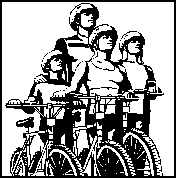Green Island News- July 2002
- Alameda Transportation Coalition Moves Ahead
- City Faces Housing Crisis
- Pedestrian & Transit Corner
- Green Party Meetings Summer Schedule
- In Memory of Hiroshima and Nagasaki
Editor: Kevin Reilly

Alameda Transportation Coalition:
|
 As the city of Alameda faces declining sales tax and income, transportation advocates are coming together in ATC to make sure that program and facilities funding for cyclists, pedestrians and transit riders is maintained. In the rush to increase development in Alameda, ATC is working to make sure that transportation impacts are properly considered in development proposals. These include congestion, pollution, limited access on and off the island, increased traffic through our neighborhoods, safe and convenient access to transit, and easy and encouraged access to pedestrians and cyclists. Alameda Transit Advocates recently scored a major victory in getting the city to upgrade all of its bus stops to AC Transit District and ADA standards by 2005. Pedestrian Friendly Alameda is forming a pedestrian and cycling safety task force with the city to increase communication between city agencies and to educate drivers and pedestrians about their rights and responsibilities. BikeAlameda is working to implement the Master Bike Plan that was put in place 3 years ago and to get the city to maintain and improve Alameda's deteriorating bike paths and routes. A combined effort by our member groups (and others) led to the recent creation of Alameda's new Transportation Commission (TC). The TIC's 9 members will create transportation proposals for the City Council to vote on and will help to create a more balanced transportation agenda in Alameda. We are proud to have 3 of our members nominated to the Commission. Development in Alameda should encourage and create better transportation equity, not make the current situation worse. If you are interested in getting involved or have questions, you can contact ATC at info@AlamedaTC.org or visit our website: http://www.AlamedaTC.org. You can find website and contact information for our member groups there as well. Write to the local news editors about this issue? |
 City Faces Housing Crisisby Eve Bach "Having evaluated the effects of Measure A more fully we do identify this constraint." Alameda city officials may have recognized the elephant sitting in the living room. The first draft of the city's Housing Element argued passionately that the City's ban on apartments, townhouses and condos, known as Measure A or City Charter Article XXVI, does not hamper the development of housing for teachers, clerks, nurses, firefighters, and others who are being locked out of the housing market by escalating housing costs. They have decided to reconsider. After running up against the law in the form of state Housing and Community Development Department officials who approve housing elements, they sought professional help. Respected real estate consultants, Keyser-Marston Associates have diagnosed the problem: "…costs for development and corresponding need for subsidy is greater for lower density projects …apartment units require less assistance due to lower construction costs which include the reduced land and site preparation costs per unit."
The Measure A Surcharge Keyser-Marston calculates that the same $66,000 surcharge would be needed to build a duplex for a family with an income of $53,000 (low income). No subsidy at all would be needed to build an apartment for a moderate-income family (income of $85,000), whereas a duplex would require a $47,000 subsidy. The citywide implications of the Keyser-Marston numbers begin to provide a picture of the problem that Measure A has created. Developing Alameda's share of the region's need for very low income, low income and moderate income housing units will require an extra $35 million because of the Measure A surcharge. |
Compounding Effects In addition, Measure A makes it almost impossible to replace Alameda's aging multi-family housing stock, almost all of which was constructed prior to 1973. More than 1/3 of the City's housing is over 60 years old; more than half is more than 50 years old. Although the City allows units destroyed by catastrophic events to be rebuilt (this was necessary to mollify the insurance industry when Measure A was passed and insurance companies were unwilling to underwrite multi-family structures that could not be replaced), it does not allow replacement of buildings at the end of their useful life because of poor maintenance, obsolescence or other reasons. As the stock of older multifamily housing deteriorates, the supply of apartments available to lower income people will shrink even though lower paying jobs are growing. Alameda needs more parks as well as housing. To address both needs, it is necessary to use scarce land efficiently.
Moving Towards a Cure Revisiting Measure A does not have to be a bitter pill. There are many options, beginning with lifting the ban at Alameda Point. The concerns that gave rise to Measure A - destruction of historic buildings, for example - can be addressed with a scalpel rather than a meat axe. It's hard to say whether it will take four steps, seven steps, or ten steps for Alamedans to replace dysfunctional Measure with new policies that address the housing crisis faced by more than half the families in Alameda. The City has taken the first step toward a cure by recognizing it has a problem. For more about the current housing crisis in the greater Bay Area check out: nonprofithousing.org. Write to the local news editors about this issue? |
 Green Party Meetings Summer ScheduleCity of Alameda Green Party
The City of Alameda Green Party usually meets the second Thursday of each month. At the June meeting members agreed to suspend meetings for the summer in
order to focus on community outreach activities. The next meeting is on Thursday, September 12th at 7pm in the Garden Room at the Home of Truth, 1300 Grand Street.
Green Party of Alameda County
|
 Pedestrian & Transit Corner
|
 Remembering Hiroshima and Nagasaki |
|
|
Rally At Carnegie Park
Join fellow Greens at the Livermore Hiroshima Day protest organized by the Tri-Valley CARES coalition at Carnegie Park in Livermore followed by a 3-mile
walk to Lawrence Livermore National Laboratory. (map) |
Vigil Commemorating Contact the sponsors listed below for more information about location and time. |
Livermore Conversion Project: 510-663-806560
|
|
Home |